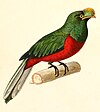| Dendrocoptes | |
|---|---|

| |
| Middle spotted woodpecker Dendrocoptes medius | |
| Scientific classification | |
| Domain: | Eukaryota |
| Kingdom: | Animalia |
| Phylum: | Chordata |
| Class: | Aves |
| Order: | Piciformes |
| Family: | Picidae |
| Tribe: | Melanerpini |
| Genus: | Dendrocoptes Cabanis & Heine, 1863 |
| Species | |
|
3, see text | |
Dendrocoptes is a genus of woodpeckers in the (family Picidae) native to Eurasia.
Taxonomy
[edit]The genus Dendrocoptes was erected by the German ornithologists Jean Cabanis and Ferdinand Heine in 1863 with the middle spotted woodpecker (Dendrocoptes medius ) as the type species.[1] The name combines the Ancient Greek dendron meaning "tree" and koptō meaning "to strike".[2] A 2015 molecular phylogenetic analysis of the nuclear and mitochondrial DNA sequences from pied woodpeckers found that the genus Dendrocopos was polyphyletic. As part of the reorganisation to create monophyletic genera, three species from Dendrocopos were moved to the resurrected genus Dendrocoptes.[3][4] The taxonomic committee of the British Ornithologists' Union recommended an alternative arrangement in which the genera Dendrocoptes and Leiopicus were combined into a larger Dendropicos.[5] The yellow-crowned woodpecker (Leiopicus mahrattensis) is closely related to the species in this genus.[6]
The genus contains three species:[4]
| Image | Scientific name | Common Name | Distribution |
|---|---|---|---|
| Dendrocoptes dorae | Arabian woodpecker | southwestern Saudi Arabia and Yemen | |
 |
Dendrocoptes auriceps | Brown-fronted woodpecker | Afghanistan, India, Nepal, Pakistan and Bhutan. |
 |
Dendrocoptes medius | Middle spotted woodpecker | northern Spain and France east to Poland and Ukraine, and south to central Italy (where local), the Balkan Peninsula, Lithuania, Latvia, Turkey, the Caucasus, and Iran |
References
[edit]- ^ Cabanis, Jean; Heine, Ferdinand (1863). Museum Heineanum : Verzeichniss der ornithologischen Sammlung des Oberamtmann Ferdinand Heine, auf Gut St. Burchard vor Halberstadt (in German and Latin). Vol. 4 Part 2. Halberstadt: R. Frantz. p. 41.
- ^ Jobling, James A. (2010). The Helm Dictionary of Scientific Bird Names. London: Christopher Helm. p. 133. ISBN 978-1-4081-2501-4.
- ^ Fuchs, J.; Pons, J.M. (2015). "A new classification of the pied woodpeckers assemblage (Dendropicini, Picidae) based on a comprehensive multi-locus phylogeny". Molecular Phylogenetics and Evolution. 88: 28–37. doi:10.1016/j.ympev.2015.03.016. PMID 25818851.
- ^ a b Gill, Frank; Donsker, David (eds.). "Woodpeckers". World Bird List Version 6.2. International Ornithologists' Union. Retrieved 5 May 2016.
- ^ Sangster, G.; et al. (2016). "Taxonomic recommendations for Western Palearctic birds: 11th report". Ibis. 158 (1): 206–212. doi:10.1111/ibi.12322.
- ^ Shakya, S.B.; Fuchs, J.; Pons, J.-M.; Sheldon, F.H. (2017). "Tapping the woodpecker tree for evolutionary insight". Molecular Phylogenetics and Evolution. 116: 182–191. doi:10.1016/j.ympev.2017.09.005. PMID 28890006.








Well, that’s interesting to know that Psilotum nudum are known as whisk ferns. Psilotum nudum is the commoner species of the two. While the P. flaccidum is a rare species and is found in the tropical islands. Both the species are usually epiphytic in habit and grow upon tree ferns. These species may also be terrestrial and grow in humus or in the crevices of the rocks.
View the detailed Guide of Psilotum nudum: Detailed Study Of Psilotum Nudum (Whisk Fern), Classification, Anatomy, Reproduction